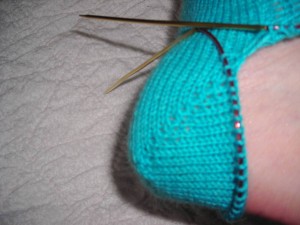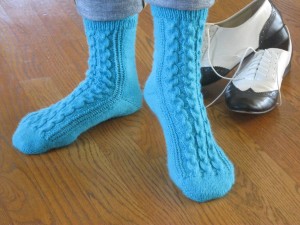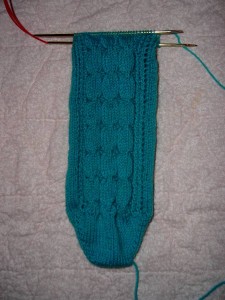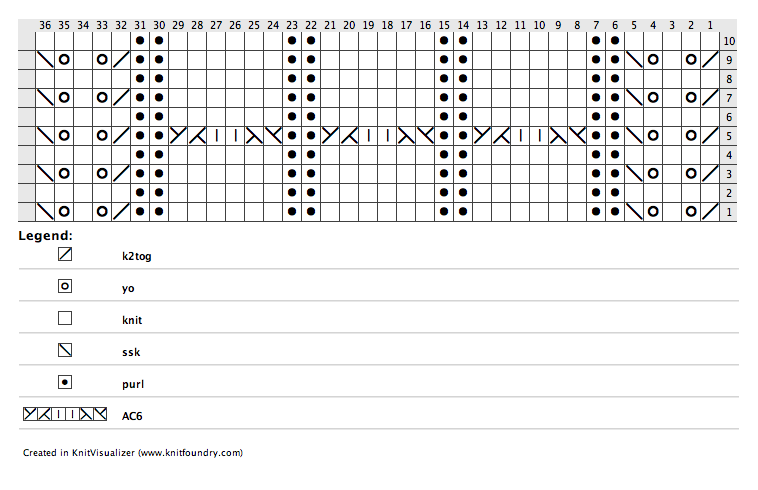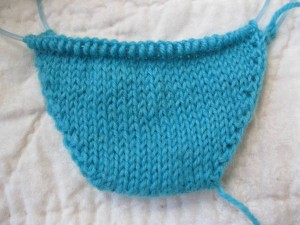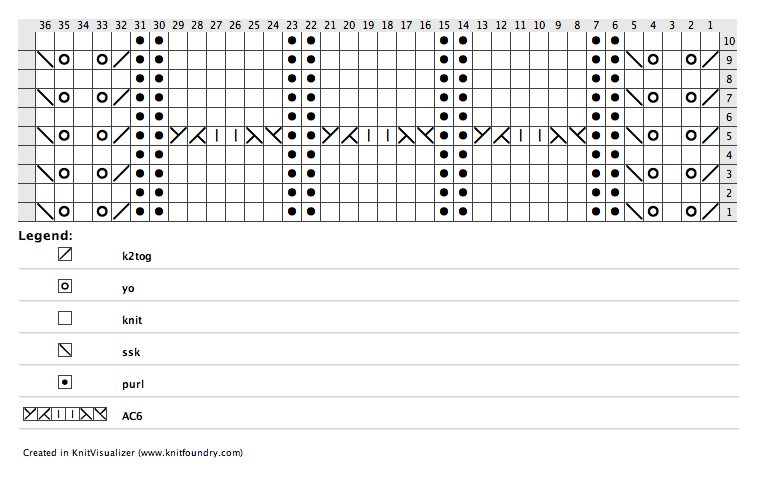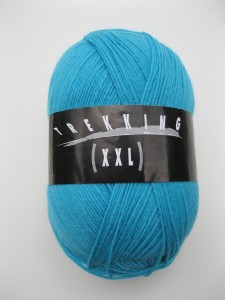Now that your heel is complete it is time to cruise on up the leg. First, let’s pause for a minute and admire the beauty of the short row heel one last time before we knit on. It really is a bit of knitting magic!
I wrote this pattern for the novice and experienced sock knitter alike. I hope the experienced sockers appreciated the challenge of a new stitch. For the newer sock knitters, especially first time toe-up sockers, the leg of this sock is quite simple. In fact it is so simple that I sheepishly give you the instructions.
To complete the sock, simply continue up the leg maintaining the instep design over the front of the leg and allowing the back of the leg to remain in stockinette. I can hear many of you groaning because there is nothing new to add! I have several reasons for this design choice:
- A simple leg allows the cables to remain at the “center of attention” and ensure that every knitter is successful.
- Knitting the design over only half of the leg means you can knit quicker and finish in time to enter the prize drawing.
- The stockinette stitches provide a good area to customize the size.
Before continuing with the leg, take some time to evaluate the circumference of the knitted foot since it will also be the circumference of the leg of your sock. Stretch the foot to see how wide it will expand for your leg. Most knitters will find that this measurement is suitable for the leg as well. If your cables were firmer or looser than mine, you may wish to make some adjustments for the leg size. The simplest adjustment is to change needle sizes at this point. The difference will be undetectable to the eye, but may provide the change you need. Other options include adding an increase (Kfb or Make One) or decrease (ssk) at the beginning and end of the first round of stockinette stitches. They will be nearly invisible since they are tucked next to the lace stitches on the chart.
If you would like to work the back of the leg in the cable design you may do so easily. Medium size knitters will need to increase the stitch count as in the Set Up Row in Part One to achieve the required 36 stitches for the design. Once the instep/front of the leg is ready for Row 1 of the charted design, work the pattern over all of the 72 stitches. This pattern modification maintains the eligibility of your sock within the prize rules.
When binding off a toe up sock, it is essential to use a loose bind off. I have seen beautiful socks become unwearable after the knitter used the standard bind and it would no longer fit over their ankle. I recommend Elizabeth Zimmerman’s Sewn Bind Off for this sock. You will love the clean line it creates while keeping your cuff edge firm yet still elastic. Watch my Sewn Bind Off Video to learn this handy bind off. To finish your two at a time socks, watch Two at a Time Socks – Bind Off for a quick tutorial.
Part Four
Click here to download printable version
AC6 (Axis Cable) – slip 4 stitches to cable needle and hold in front of work, knit 2 stitches from left hand needle, return 2 center stitches from cable needle to left hand needle, move cable needle to back of work, knit 2 center stitches, knit 2 stitches from cable needle. See Axis Cable Video
k2tog – knit two together. See k2tog Video
ssk – slip next stitch as if to knit, slip next stitch as if to knit, insert left needle into the front of these two slipped stitches from left to right and knit together. See ssk Video
yo – yarn over. See Yarn Over Video
Directions are for women’s Medium (directions for Large in parentheses when necessary).
Leg
Continue knitting in the round with first 36 stitches worked in design pattern (see chart above) and last 32(36) remaining in stockinette (all knit) until leg reaches 5” or desired height ending after Row 10.
Cuff
All Sizes: Work a k1, p1 rib for 1”.
Bind off using sewn bind off method. See Sewn Bind Off Video
I consider a knitting project the most essential item in any survival kit.
Who would want to be stranded without it?
©2013 Michelle Hunter
www.knitpurlhunter.com
October Knit Along
Join me this Fall for a beautiful colorwork cowl featuring four colors of Kenzie by HiKoo. Kenzie is a gorgeous tweed from New Zealand with yummy colors and superior softness. Size Small – four skeins will yield a cowl up to 32″. Size Large – 8 skeins (2 each of four colors), knits the season’s must-have infinity scarf 60-68″ to wear fashionably doubled. Just in time for your Holiday knitting! My favorite sample is knit to 64″ in the featured colors pictured below: #1000 Pavlova (natural), #1006 Kumara (orange), #1007 Kiwifruit (green) and #1009 Oceania (navy).
Supplies
Size Small – up to 32″. (Size Large up to 68.”)
1(2) skeins each of 4 different colors of Kenzie, 160 yards/50g each. 50% New Zealand merino, 25% nylon, 10% angora, 10% alpaca, 5% silk noils.
US #7, 16″ circular needle
US#8, 16″ circular needle
Two removable stitch markers
Gauge – Approximately 20 stitches = 4″ in stockinette.


